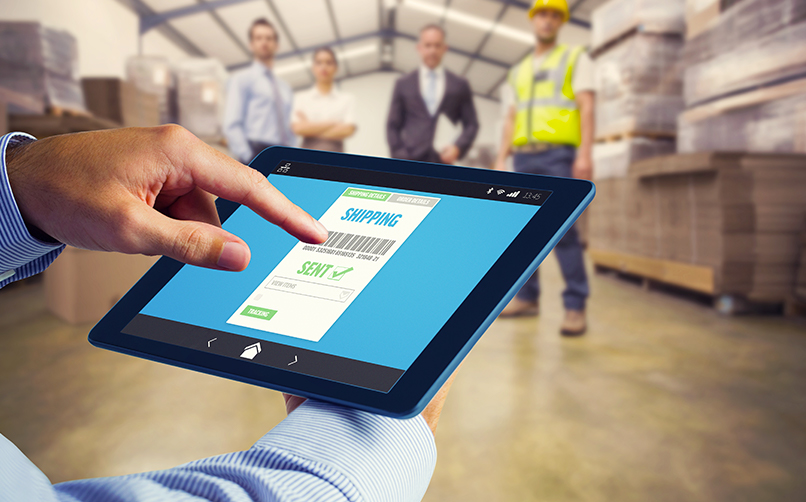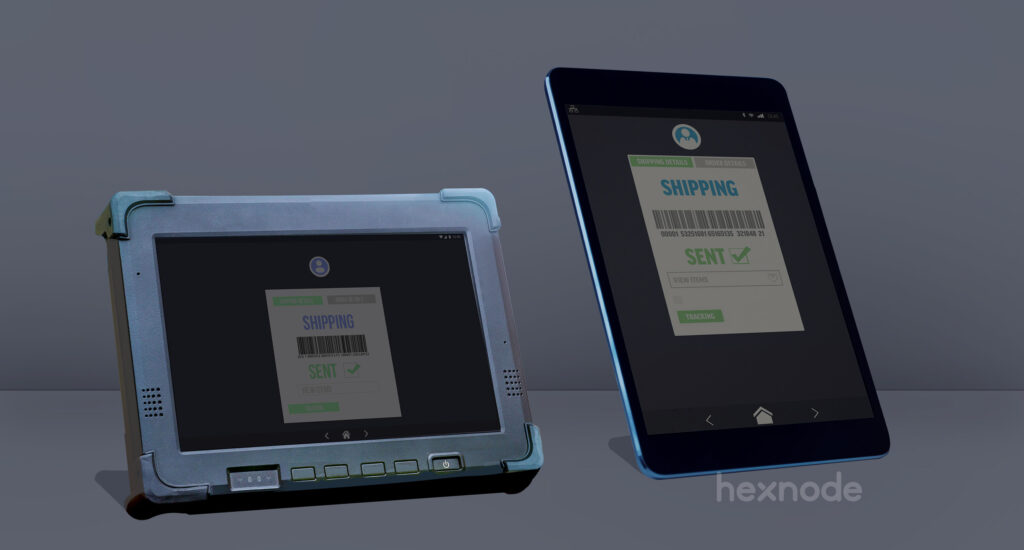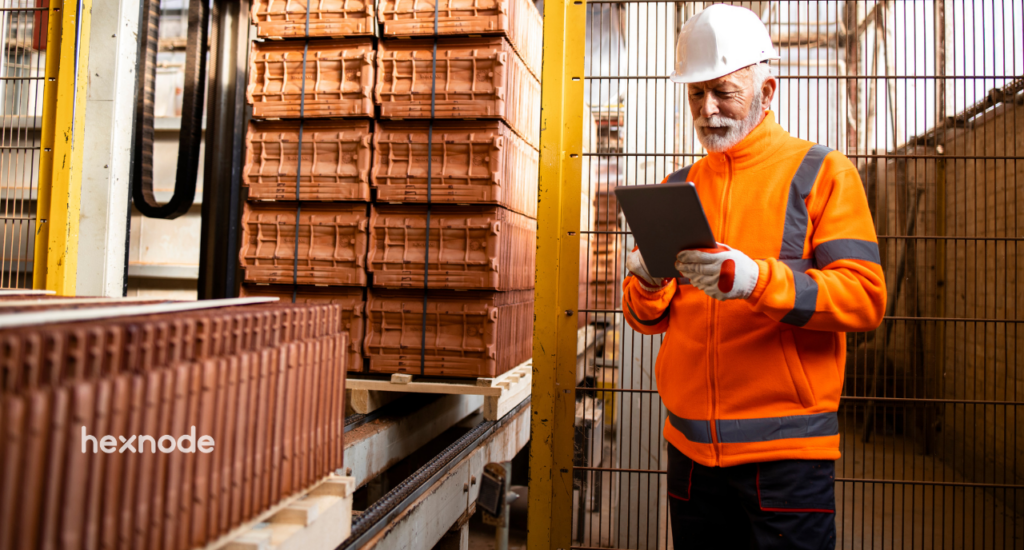When organizations look to choose their worker devices, they have to decide on a variety of factors like device functionalities, operating systems, price points, and so on. But before going into device-by-device comparisons, a pivotal decision to make is whether to go for rugged devices or consumer devices. However, there are many uncertainties surrounding the choice of deploying between consumer and rugged devices. In this post, we will compare some important aspects of rugged and consumer devices, including when and where it makes sense to use each, with some tips on choosing wisely between them.
- First, a little backstory
- Rugged vs consumer devices: Key considerations in the decision making process
- Cost
- Durability
- Ease of use
- Work environment
- Device configuration
- Software support
- Wi-Fi performance and screen size
- Power management
- Security
- Device management
- The jury is in on the “rugged vs consumer devices” confusion
First, a little backstory
Back when smartphones were debuted, rugged mobile computers were ubiquitous in industrial use and the newly introduced smartphones targeted only consumers, hence used nowhere at the enterprise level. Fast forward to today, consumer devices are becoming more and more common in organizations owing to the reliance the employees have upon them. Over the past few years, we have witnessed consumer technologies like smartphones and tablets being used for industrial applications, and the trend became more invasive as companies allowed BYOD.

The fast incorporation of the latest sophisticated technologies to smartphones tempts organizations to rely on consumer devices for their mobile workforce; their familiarity is a further encouraging factor. They are easy to carry around, being designed with a small form factor.
On the face of it, this seems like a judicious choice. After all, businesses are getting most of the jobs done most of the time, mostly well with their most convenient, less expensive gadgets. Then, why should they go for anything else, right? But this is not going to be always right. We cannot assume that consumer-grade devices will work just fine in all use cases.
Another general practice seen is that small or medium sized businesses mostly adopt consumer-grade devices considering operations levels, minimum cost, and employee satisfaction. In contrast, larger companies opt to invest in standard ruggedized enterprise devices. But this trend is currently shifting in terms of many other vital considerations which matter a lot when organizations make their decision. There might be many other things offered by rugged devices that align with the use cases to outweigh the convenience provided by consumer devices in some or other enterprise applications. Let us evaluate them one-by-one.
Rugged vs consumer devices: Key considerations in the decision making process

The rugged vs consumer devices argument has gone on for years, and in the initial days, the main concerns were price vs durability and specifications. However, the confusion hasn’t been resolved conclusively as there was room for both consumer and rugged devices in enterprise use cases according to the concerns then.
On account of the increased call for ruggedization of consumer devices, the lines between rugged and consumer devices are blurring, and this is another factor that sidestepped the whole rugged vs consumer devices discussion that typically comes into play. But the ruggedization factors are not adhered to as stringently for consumer devices as for purpose built rugged devices. And hence, this debate is still relevant.
The enterprise paradigm is quite different from the consumer case where the priority is given to the end-user convenience. This is an important consideration to realize where your business could benefit from rugged and consumer devices. Now, let us quickly breakdown the essential differences between rugged devices and consumer devices when they are into supporting enterprise operations.
Cost
The cost of consumer devices has come way down compared to their initial launch, so most of them will now comfortably trounce their rugged counterparts on the initial price. The purchase price of a consumer-grade device is relatively affordable.
When organizations look to cut corners and pick their device by cost alone, it is far more tempting to opt for consumer devices. But when the total cost of ownership for the device over the long run is considered, rugged devices can actually save more. So, it is important to consider that low initial cost doesn’t mean that consumer devices are more profitable. The total cost of ownership (TCO) of a device involves all the tangible and intangible expenses, including:
- Upfront acquisition cost
- Deployment cost
- Training cost
- Support cost
- Maintenance and service costs
- Cost of downtime
and much more.
In that sense, the overall cost of maintaining, managing, and replacing rugged devices is considerably inexpensive than consumer devices for several reasons, although the upfront cost of procuring rugged devices seems high.
| The hidden costs of consumer devices | The real value of rugged devices |
| Irreplaceable battery causes frequent, costly service center battery replacements. | Replaceable battery and full shift battery power. |
| Productivity loss due to device downtime. | Less to no downtime. |
| Frequent repairs are needed due to device failures, which also translate into a higher cost of ownership. | Exceptional quality causes less need for repairs. |
| High expense due to the frequent need for device replacement. | No need for frequent device replacements. |
| Additional software, services, and peripherals are needed, which causes extra costs. | No additional services are needed. |
| With new technologies arriving at consumer phones, it is quite challenging to provide a consistent set of consumer hardware and software over an extended period of time. The cost of accommodating these new changes add to the total cost of ownership for the device. | No new technologies are frequently introduced and so there is no need for frequent updates. |
Durability
Consumer devices have a higher frequency of failure and hence a shorter life cycle than rugged devices and are often phased out quickly. Tablet cases can increase the typical shelf life of consumer devices, but they are in no way a permanent substitute for the longevity that rugged devices can offer. Rugged devices trump a consumer tablet quite easily as they are incredibly durable so that businesses can support them for years.
Ease of use
Consumer devices have steadily been better than rugged devices in terms of ease of use, which is making them alluring for enterprise use. It is easy to repurpose consumer devices for business purposes due to their compact nature and familiarity with the users. They also have advantages when it comes to factors like screen size and portability, which make them sure bets regarding ease of use.
Work environment
The right device choice heavily depends on each organization’s specific work processes and the usage environment the devices will be in. The working environment of some of the enterprises will be harsher than the others. Consumer devices weren’t designed to work in such trying environments. That is why consumer devices are not considered fixed parts of enterprise operations.
Unlike consumer devices, rugged devices are specifically engineered to work in fast-paced tough environments with proven protection against adverse factors like fluctuating temperatures, vibrations, pressure, exposure to water and dust, extreme cold, and direct sunlight. Rugged devices have a long battery life, high processor speeds, more excellent screen resiliency to light and moisture, better acoustics, tougher drop-resistance, larger memory, and advanced screen technologies such as Gorilla Glass – all designed for challenging work environments. Thus, rugged devices being robust and hard-wearing, excel without malfunctioning in benign environments where consumer devices don’t. Consumer devices may need additional housing to protect them from spills and inclement weather.
Device configuration
Rugged devices are more flexible than consumer devices and typically allow customization options to match the work environment. Hardware personalization enables the device to be configured to the optimal work conditions allowing employees to work efficiently thereby increasing productivity and meeting customer expectations. Consumer devices can rarely be customized with essential job tools.
With a wide variety of device specifications available, rugged devices still have the upper hand here too. Besides, they are also used for applications like barcode scanning and inventory management, which would be possible by a consumer device only if a couple of gadgets are additionally connected as they are developed with only convenience and consumer attractiveness in mind. Rugged devices have more precise barcode scanners, support for RFID scanning, and multiple wireless networking options. These options may not be available with consumer devices that are designed for much lighter usage.
Software support
Software support is currently less of an issue in the consumer vs rugged debate as both parties support most of the popular operating systems. Still, it is important to consider that rugged devices allow more OS personalization than consumer devices. Most of the legacy warehouse software are designed for Windows-based devices, and most rugged devices are capable of terminal emulation to access the legacy applications, which means that they can duplicate the performance of older devices used with legacy warehouse applications.
Wi-Fi performance and screen size
Wi-Fi performance draws a clear difference between rugged and consumer devices. Consumer devices typically have poor roaming efficiency, which may significantly impact productivity. Wi-Fi connectivity is one of the compromises made by manufacturers to tradeoff with reduced costs.
Screen size is another demanding factor that has to be balanced with pocketability. Consumer devices, however, managed to respond to customer demand for increased screen size without compromising their ease-of portability. Larger screens that enable portrait and landscape modes are essential for enterprise use, which both rugged and consumer devices can offer.
Power management
Enterprise use often places considerable stress on the battery life of devices. The enterprise devices may have to handle multiple long hours shift schedules with multiple workers and provide 24-hour operational efficiency where the consumer devices often fail over time due to battery erosion as they are not meant for repeated cycling. Rugged devices, on the other hand, have durable battery life, long outdoor battery durability, a removable battery that can be swapped instead of taking the devices out for charging, and extended battery packs in order to support long durations of work out in the field.
Security
Consumer devices being built with a number of usability features are more susceptible to cyberattacks and are easily lost or stolen, causing unauthorized access to the data punching holes in the corporate security walls. It is easy to get access to device details on a consumer device, and so if the device is lost or stolen and reaches the wrong hand, he can get access to emails, contacts, text messages, voice input, user data, and other sensitive parts of the device. Moreover, the after-market demand for consumer devices is high, making them an attractive target for theft.
Consumer devices may provide easy access to the device data, breaking corporate security policies and breaching confidential data. A data breach can also happen due to applications downloaded via the App store, which may compromise important data like search history, auto-completion history, Wi-Fi connection logs, device identifier, address books, and recent views.
Ruggedized devices provide enhanced security features for the lockdown of applications so that users can access only what is required, which prevents hacking into the company network. Not only in terms of cybersecurity, but rugged devices also provide extra levels of security in hazardous working areas like volatile chemicals where consumer grade devices are not even permitted to enter.
Device management
Another seldom-thought-of aspect of choosing the right device for your enterprise is the device management options available. Consumers, due to privacy concerns, often won’t allow leveraging secured devices like Android GMS certified devices, and the non-secure consumer devices they choose would not comply with the organization’s security policies. For instance, OS updates are pushed to consumer devices bypassing IT. With this in mind, businesses should take a step further through mobile device management platforms to take care of the issues surfaced around consumer devices in the workplace. MDM can limit or lock features that may deem unproductive.
The scope of device management on such devices is also less. Most consumer devices are built relatively closed, and this limits the ability of developers to add advanced management features. Though MDM solutions like Hexnode offer high end management options for consumer or BYOD devices, most of the generic features are built solely for corporate owned devices due to the limitations on consumer devices as part of the privacy concerns.
An enterprise-grade rugged device can more easily be managed through an MDM solution that restricts its usage solely for work purposes. Rugged devices are typically corporate liable devices, which is a benefit the MDM solutions can leverage to push powerful features to manage mission-critical devices. Specific features like OEMConfig are more targeted towards rugged devices and make it easy to manage them. With a rugged, enterprise-grade device, the enterprise IT has full control over the devices to initiate timely actions and lessen the obstacles than reduce the end user operational ability. Hexnode, with its unique management and security capabilities, provides a simple yet efficient solution for rugged device management.
The jury is in on the “rugged vs consumer devices” confusion

Undoubtedly, from what we have discussed so far, it is evident that the rugged device is the clear winner as it offers more bangs for your bucks. Only sticker price, availability and user comfort are the true arguments for consumer devices, outside of slight differences in learning curves and adoption rates that make them a viable option. Still, it is wise to conclude that the best practice is to learn as much as possible about the real-world behavior of the devices before making a choice between rugged and consumer devices. If you have any specific concerns, look at the bigger picture and consider investing in quality hardware designed for the task rather than just going before the price tag. And a proven methodology is to adopt a dynamic mobile device management solution that is flexible to handle consumer or ruggedized devices and accelerate rapid deployments, drive optimized business performance, extend the life cycle, and strengthen your enterprise security.





